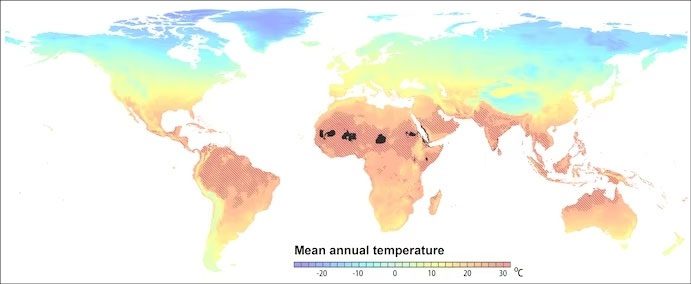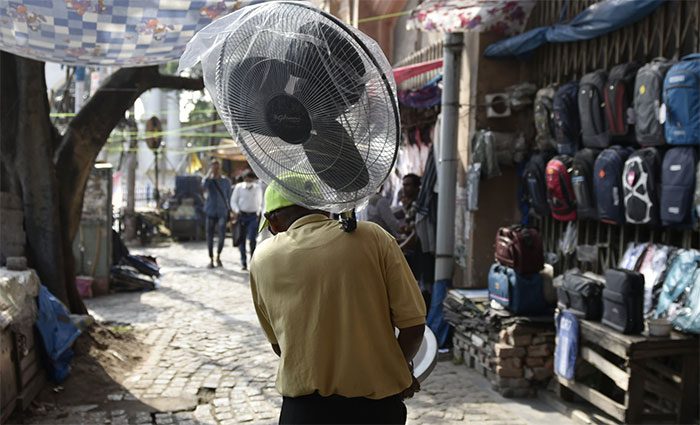Scientists Warn the World is on Track to Rise by 2.7°C, Leading to Extreme Heat Weather for Humanity.
Global warming is set to push billions of people out of the climate conditions that have supported human development for millennia, forcing them to confront unprecedented heat and extreme weather, according to a new study reported by The Guardian on May 22.
The world is on track to increase by 2.7°C if current action plans continue as they are. This means that 2 billion people will have to live in average annual temperatures exceeding 29°C by 2030, a temperature that very few communities have experienced before.

Under current climate conditions, annual average temperatures above 29°C are limited to small dark areas in the Sahara region. By 2070, this temperature is predicted to occur across the shaded regions in a worst-case climate change scenario. The background color represents the current average annual temperature. (Photo: Professor Chi Xu, Nanjing University, China/Washington Post).
Everyone Faces Global Warming
Scientists indicate that up to one billion people may choose to migrate to cooler areas, although the remaining regions within suitable climate zones will still face more frequent heatwaves and droughts.
However, urgent action to reduce carbon emissions and keep global temperature rise to 1.5°C could reduce the number of people displaced from suitable climate environments by as much as 80%, down to 400 million.
This study is the first analysis of global warming at this scale, applying to all people, unlike previous economic assessments of climate crisis damages which have favored the wealthy.
In populous, warm countries, most residents will be pushed out of suitable human climate zones, with India and Nigeria facing the worst changes.
India has already endured severe heatwaves. A recent study shows that more than one-third of heat-related deaths during summer from 1991 to 2018 occurred as a direct result of human-caused global warming.

India and Nigeria face the worst climate changes. In the image, a man carries a fan during a heatwave in Kolkata, India. (Photo: Reuters).
Professor Tim Lenton at the University of Exeter (UK), leading the new study on global warming, states: “The cost of global warming is often expressed in financial terms, but our research emphasizes the human cost of failing to address the climate emergency.”
He adds: “Economic estimates almost always prioritize the rich over the poor, as they have more assets to lose and tend to value those currently living more than those who will live in the future. We consider all people equal in this research.”
Impacts
Professor Chi Xu at Nanjing University (China), also a member of the research team, shares: “Such high temperatures are linked to issues including increased mortality rates, lower labor productivity, decreased cognitive performance, poor learning outcomes, negative impacts on fertility, reduced crop yields, heightened conflict, and the spread of infectious diseases.”
Professor Marten Scheffer at Wageningen University (Netherlands), the lead author of the study, points out that those pushed out of suitable climate zones may consider migrating to cooler areas. He states: “It’s not just the migration of tens of millions, but potentially a billion people or more.”
The idea of suitable climate environments for wildlife and plants has long existed, but the new study, published in Nature Sustainability, identifies the climate conditions under which human society has thrived.
It shows that most people live in locations with average annual temperatures ranging from 13-25°C. Conditions that are too hot, too cold, or too dry are associated with higher mortality rates, lower food production, and reduced economic growth.
“The suitable climate environment describes where humans have developed and thrived for many centuries, if not millennia, in the past. When humans are outside the suitable climate environment, they cannot thrive,” says Professor Tim Lenton.
Professor Marten Scheffer notes: “We were surprised by the extent of human limitations when it comes to climate-related distribution; this is a fundamental issue we need to address.”
In the study, scientists used climate and population models to examine potential future changes in the number of people living outside the climate zone they defined as experiencing average annual temperatures above 29°C.
They reported that there are currently 60 million people living outside suitable climate environments and exposed to dangerous temperatures. However, for every 0.1°C increase in global temperatures beyond the current 1.2°C of human-induced warming, an additional 140 million people will be pushed out of suitable climate environments.

Many countries in Southeast Asia are experiencing drought and record high temperatures in April and May. (Photo: Reuters).
If global temperatures continue to rise by 2.7°C, the combination of warming with the increasing global population means that 2 billion people will live outside suitable climate environments by 2030, and this figure could increase to 3.7 billion by 2090.
In a worst-case scenario, climate warming will be more sensitive than expected to greenhouse gas increases, leading to a global temperature rise of 3.6°C, pushing nearly half of the world’s population outside suitable climate zones.
Addressing the Situation
Researchers found that rapidly and deeply cutting emissions to keep temperatures at 1.5°C would significantly reduce the number of people living outside suitable climate environments.
For instance, 90 million people in India would be living in areas with average temperatures above 29°C, compared to 600 million if global temperatures rise to 2.7°C. Other countries that would be severely impacted by high temperatures include Indonesia, the Philippines, and Pakistan.
Professor Tim Lenton emphasizes that the study highlights “the significant inequality” of the climate emergency, with low-emission individuals facing the greatest changes when exposed to extreme heat.
He suggests that the most practical and immediate option for adapting to high temperatures is to increase green space in cities. He notes: “This could reduce extreme temperatures by 5°C and provide shade, which is fantastic.”
Dr. Richard Klein at the Stockholm Environment Institute (Sweden), who is not a member of the team, states: “What this research clearly indicates is the direct suffering of humans that climate change can cause; living outside suitable areas means enduring unbearable heat and potentially humid climates.”
Dr. Laurence Wainwright at the University of Oxford (UK) comments: “Humans have become accustomed to living in specific areas with certain temperatures. When things change, serious problems will arise, whether related to physical health, mental health, crime, and social unrest.”



















































